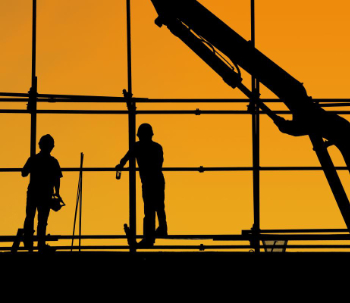Construction industry outlook on the upswing
Contents |
[edit] Introduction
Following years in the wilderness, with several high-profile casualties, Brexit, and even a global pandemic to contend with, is the future of the construction industry finally beginning to look more positive? A £1.3 billion investment for the construction of new houses from the Government in 2020 is one of the first steps in a brighter outlook for the industry.
[edit] Early signs of a slow recovery?
The first sign that things are heading in the right direction, at least from an economic point of view, is highlighted by the IHS Markit/CIPS Purchasing Managers' Index (PMI) rating. Used to highlight global economic trends in the manufacturing and service sectors, June 2020's record jump of 11.4 index points was a five-month high – and a statistic that shows a correlation between lockdowns easing and economies starting to recover.
But with the global index covering much more than just the UK, it's important to dig a little deeper to see what the state-of-play looks like for the country's construction industry. The Office for National Statistics (ONS) showed that construction output suffered a 40% collapse in April 2020, with the pandemic behind a 41.2% decrease in new work and 38.1% decrease in repair and maintenance. Not only do the dramatic falls represent a financial hole of £5.1 billion, but they also account for the most significant drops since records began in 2010.
May 2020 figures show a small sign of improvement for construction output, with an 8.2% increase – compared to April's figure – being accredited to the easing of lockdown restrictions. It's impossible to say whether things have continued to improve, but with May 2020's slight increase and June 2020's PMI record rating jump, the hope is that the industry continues to head in the right direction. However, even the ONS admits that it's difficult to quantify the exact impact of the coronavirus alone, with the unpredictability of a virus that could have a second, third or fourth wave.
[edit] Timely boost from the government
To help plug the £5.1 billion black hole caused by the downturn in output, tens of thousands of new homes and other vital infrastructure projects have been given the green light thanks to a £1.3 billion investment by Housing Secretary Robert Jenrick. The move is part of the government's plan to deliver upgrades to local infrastructure and boost skills to help trigger a green economy recovery.
The investment is expected to deliver up to 45,000 homes, create up to 85,000 jobs and reduce around 65 million kgs of CO2 emissions across England. It's a perfectly timed boost for an ailing industry desperate for a helping hand to kickstart its recovery.
Andrew Thompson, Managing Director of Sunderland-based Mobile Mini, who supply storage containers and portable site accommodation to the construction industry, said: "It's clear that the Government stimulus, such as Build Build Build, coupled with the announcement of the removal of red tape within the planning permission process and the support with stamp duty, has further ignited a confidence within the construction sector.
"There is a real and tangible air of determination to not only recover lost ground, but also a true British bulldog spirit to beat COVID-19. This is evident within the demands of our business and the strength of our pipeline, which is why we have recently invested over £2m in additional products.
"There is no doubt that the furlough scheme has given businesses breathing space to adapt and rebuild. However, the UK supply chain is still restricting that growth and rebound opportunity. If we can accelerate the supply chain recovery to meet the country's demand for construction, then we will undoubtedly see an impressive 'V recovery'."
[edit] The need to be safe as houses
Whilst construction output and economic recovery will still take time to reach levels seen well before the virus hit, another aspect to consider from the eased restrictions is the return of people to work on construction sites – and the health and safety of working conditions.
Not only must workers be able to carry out work under standard health and safety regulations, but there's the added caveat of following social distancing and hygiene measures – putting an even greater focus on health and safety in the construction industry.
On one hand, you have the introduction of the Building Safety Bill, which takes forward reforms of the building and fire safety system – for how a building is built and how safe it is once the structure is complete. On the other, the Construction Leadership Council's Site Operating Procedures during COVID-19 are aimed at protecting workforces from the virus.
The former is a notable introduction since the aftermath of the Grenfell Tower disaster, and the latter will develop over time, as the guidelines have already had five iterations, with plenty more issues to be produced if the pandemic continues to change at a speed that feels like it's overnight.
Both are positive steps for improving conditions within the industry and pivotal if the world of construction is to move forward positively.
Although not directly connected, the two pieces of legislation do work in tandem. Without the Safety Bill, you run the risk of unsafe buildings built in an unsafe way, and without the guidelines for working during COVID-19, you can't implement the new ways in which buildings have to be built, all the way from design to completion.
[edit] The construction site as a workplace
And among all of this is the workers and their working environment. Life on a construction site can be challenging. It's less collaborative working spaces and more using the land in which the building is being built on.
There's a huge range of on-site facilities needed during projects, including offices, canteens, drying rooms, toilet blocks and storage facilities in a variety of sizes and layouts – with these facilities often found inside a storage container.
The close proximities of workers make social distancing a tough measure to get right, with the threat of site closure if guidelines are not implemented correctly.
But the good news is that a course for safe working during the pandemic has been launched by industry specialists. CovCert is an online programme designed to provide employees with an understanding of how to work safely and minimise the risks from COVID-19.
The initiative is a collaboration between industry expert Green Hat Consulting and construction workforce specialist Sphere Solutions – and will serve to educate and ensure that construction sites continue to be safe and compliant.
Speaking about the course, Andrew Warring, managing director of Green Hat Consulting, said: "CovCert is aimed at employees who are returning to work on construction sites. The courses are intended to raise COVID-19 awareness and provide employees with the knowledge required to minimise the risk of transmission and infection within the workplace, as well as providing an induction for new employees and informing on up to date guidance."
It's another positive step in the right direction and will help those who've been unsure of going back to work to be more confident on the construction site, which will no doubt benefit the company they work for and the project they're helping to complete.
Overall, there's slight indications that the industry is starting to see a positive upturn in its fortunes, although there's still a lot of work to be done and the unknown of what the actual impacts of Brexit will be. With such an unpredictable virus and landscape for the world of construction, it's important that small steps are made as frequently as possible to avoid another decade in the doldrums.
This article originally appeared on the CIAT website under the headline, 'The future of construction – is the industry finally on the up?' It was published on 14 October 2020.
--CIAT
[edit] Related articles on Designing Building Wiki
- Affordable housing.
- Beyond the pandemic.
- Brexit.
- Budget 2020.
- Building Safety Bill.
- CIAT articles.
- Coronavirus and the construction industry.
- Covid 19 and the new normal for infrastructure systems.
- Get ready for green jobs and upgrade projects.
- Global construction market projections from 2020 to 2030.
- New deal for infrastructure 2020.
- UK construction industry.
Featured articles and news
Airtightness in raised access plenum floors
New testing guidance from BSRIA out now.
Picking up the hard hat on site or not
Common factors preventing workers using head protection and how to solve them.
Building trust with customers through endorsed trades
Commitment to quality demonstrated through government endorsed scheme.
New guidance for preparing structural submissions for Gateways 2 and 3
Published by the The Institution of Structural Engineers.
CIOB launches global mental health survey
To address the silent mental health crisis in construction.
New categories in sustainability, health and safety, and emerging talent.
Key takeaways from the BSRIA Briefing 2024
Not just waiting for Net Zero, but driving it.
The ISO answer to what is a digital twin
Talking about digital twins in a more consistent manner.
Top tips and risks to look out for.
New Code of Practice for fire and escape door hardware
Published by GAI and DHF.
Retrofit of Buildings, a CIOB Technical Publication
Pertinent technical issues, retrofit measures and the roles involved.
New alliance will tackle skills shortage in greater Manchester
The pioneering Electrotechnical Training and Careers Alliance.
Drone data at the edge: three steps to better AI insights
Offering greater accuracy and quicker access to insights.
From fit-out to higher-risk buildings.
Heritage conservation in Calgary
The triple bottom line.























